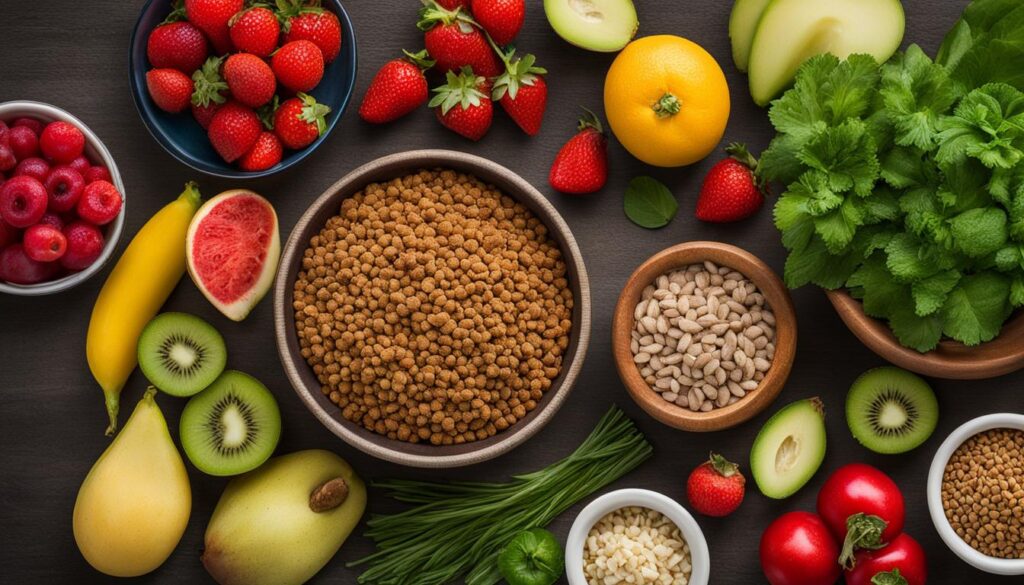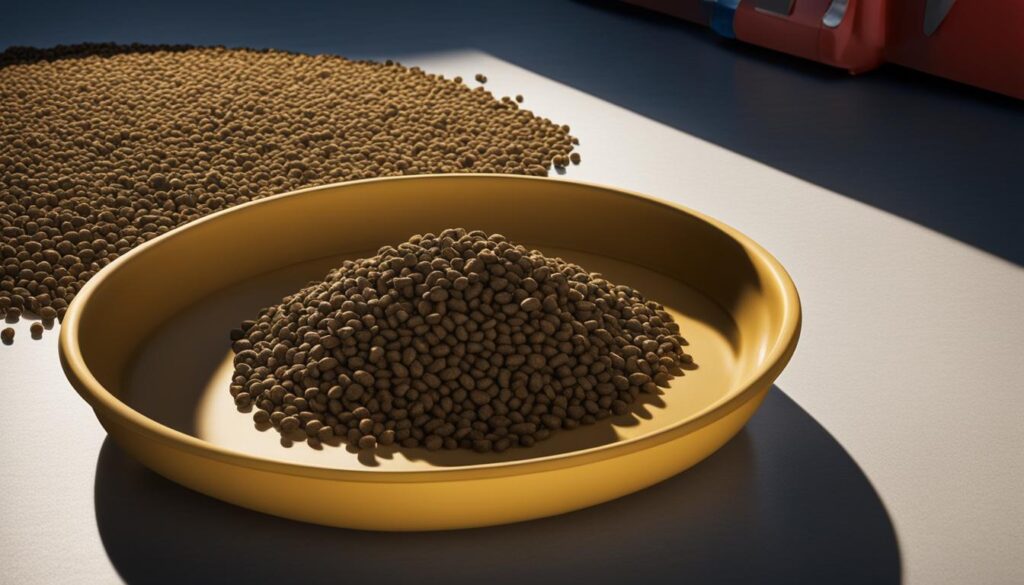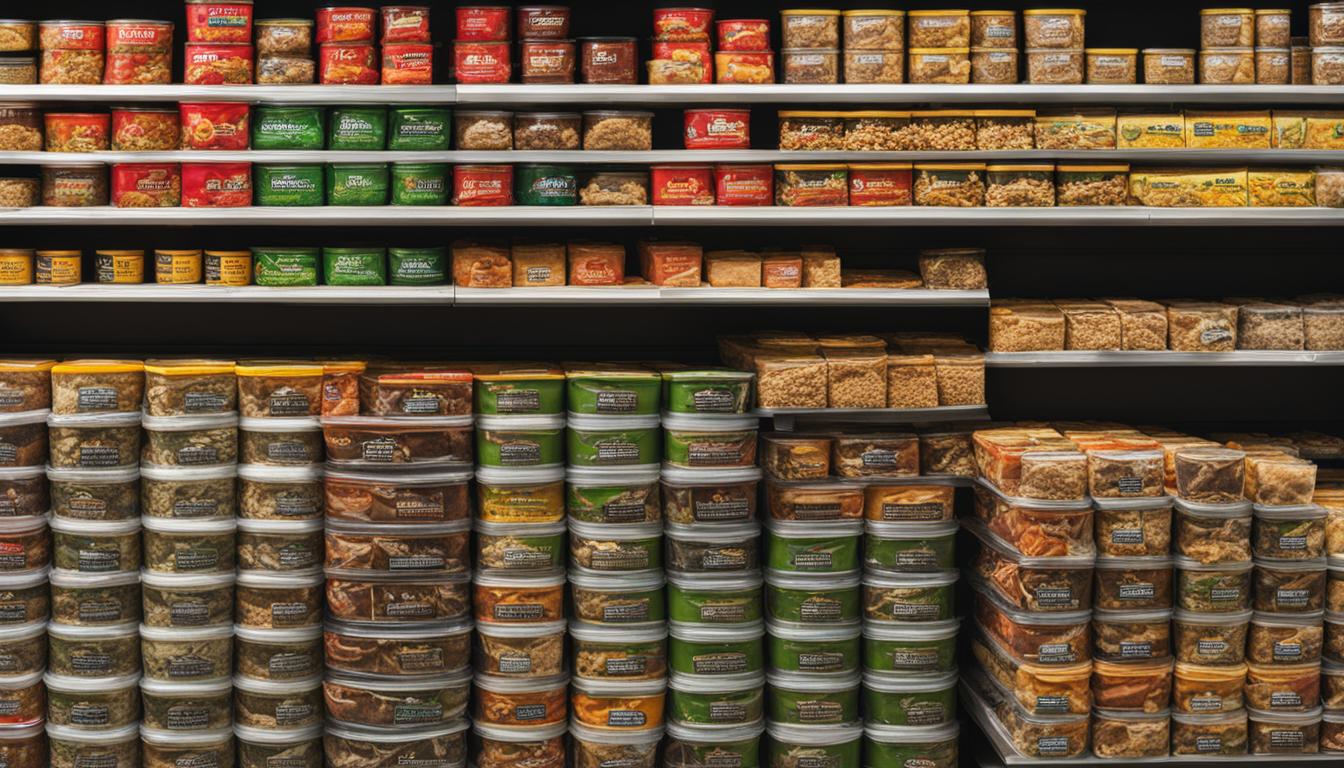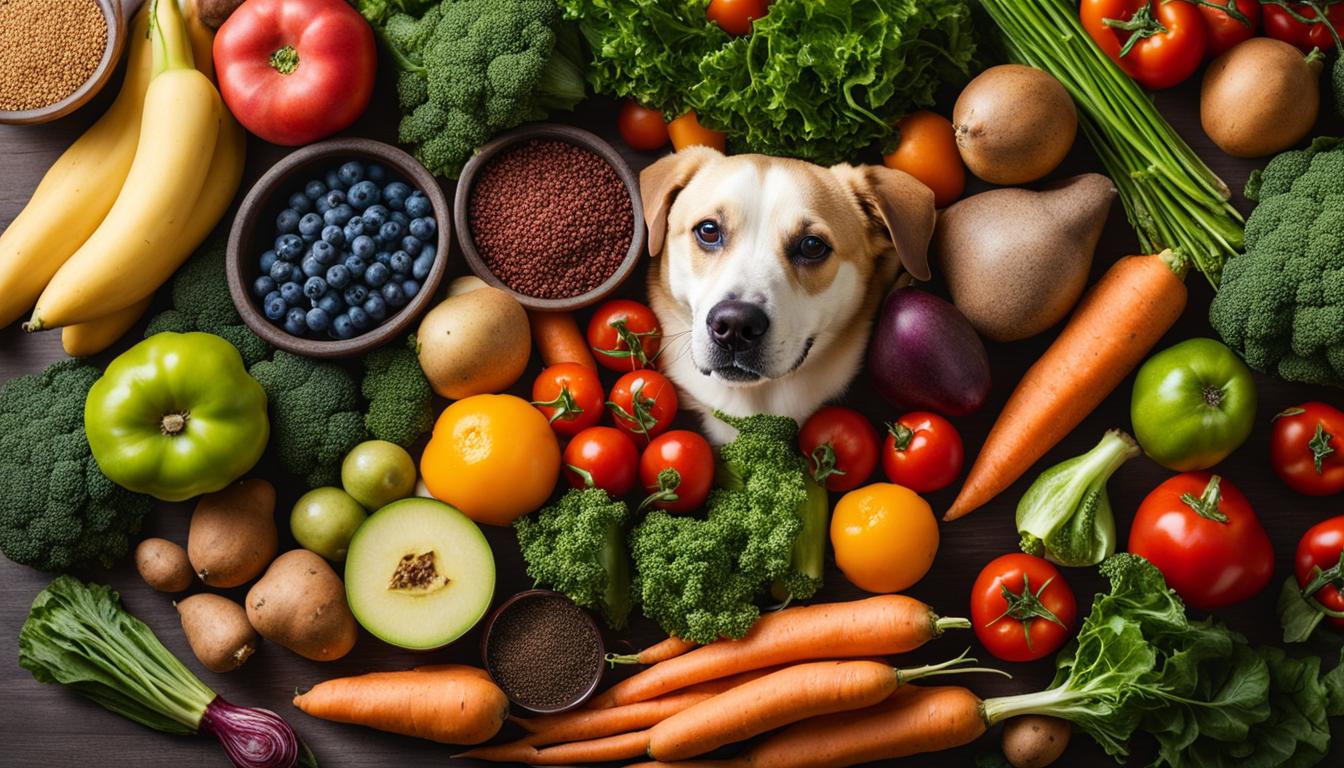Have you ever wondered what goes into your beloved furry friend’s food? The topic of additives in pet food can be confusing and concerning for many pet owners. These additives serve various purposes, such as preserving freshness, enhancing taste, and providing essential nutrients. But not all additives are created equal, and the debate surrounding artificial additives in dog food has sparked discussions about their necessity and safety.
This comprehensive guide aims to demystify the world of pet food additives and delve into the ongoing debate surrounding artificial additives in dog food. We’ll explore the different types of additives, the importance they play in pet food, safety measures and regulations in place, the rise of natural alternatives, and the concerns and controversies associated with these additives. By the end, you’ll have a better understanding of what goes into your dog’s food and how to make informed choices for their health and well-being.
Key Takeaways:
- Understanding the purpose of additives in pet food
- The role additives play in extending shelf life and enhancing palatability
- The importance of staying informed about pet food industry regulations
- The ongoing debate between natural and artificial additives in dog food
- Potential health concerns and allergies related to certain additives
What Are Additives in Pet Food?
Pet food additives are substances added to serve specific purposes such as preserving freshness, improving taste, or providing essential nutrients. These additives can be broadly classified into two categories: nutritional and non-nutritional additives.
Nutritional additives are ingredients that provide essential vitamins, minerals, and other nutrients that contribute to a balanced diet for your pet. These include vitamins like A, D, and E, as well as minerals like zinc and iron. Nutritional additives are crucial for maintaining your dog’s overall health and well-being.
Non-nutritional additives, on the other hand, serve different functions such as enhancing flavor, improving texture, or extending the shelf life of pet food. These additives include flavor enhancers, colorings, and preservatives. While they may not contribute to the nutritional value of the food, they play a role in making the food more palatable and appealing to your furry friend.
Understanding the different types of additives is important when evaluating the overall quality and safety of the dog food you choose for your pet. While nutritional additives provide essential nutrients, it’s essential to consider the necessity and potential risks associated with non-nutritional additives in order to make an informed decision.
| Type of Additives | Examples |
|---|---|
| Nutritional Additives | Vitamins (A, D, E), Minerals (zinc, iron) |
| Non-nutritional Additives | Flavor enhancers, colorings, preservatives |
The Importance of Additives in Pet Food
When it comes to pet food, additives play a crucial role in ensuring the quality and palatability of the products we feed our beloved furry friends. These additives have a significant impact on the shelf life of pet food, ensuring that it remains fresh and safe for consumption over a longer period. With additives, pet food can also be enhanced in terms of taste and texture, making it more appealing to even the pickiest eaters.
One of the key benefits of additives in pet food is their ability to extend the shelf life of the products. By incorporating preservatives, pet food manufacturers can prevent spoilage and maintain the nutritional integrity of the food for a longer time. This not only reduces waste but also offers convenience for pet owners, as they can stock up on their pet’s favorite food without worrying about it going bad.
In addition to extending the shelf life, additives also play a vital role in enhancing the palatability of pet food. Flavor enhancers are used to make the food more appealing to our pets, enticing them to eat and ensuring they receive the necessary nutrients. This is especially important for pets who may be selective with their food choices or have medical conditions that affect their appetite. Additives can help make mealtime more enjoyable for both pets and their owners.
The Shelf Life of Pet Food
The shelf life of pet food refers to the length of time that a product can be stored without spoiling or losing its nutritional value. This is particularly important for pet owners who prefer to buy in bulk or want to have a backup supply of their pet’s food on hand. Thanks to preservatives and other additives, pet food can have a longer shelf life, ensuring that it remains fresh and safe for consumption until the expiration date indicated on the packaging.
The Palatability of Pet Food
The palatability of pet food refers to its taste and texture, which greatly influences whether our pets will eat it or not. Pets, like humans, have their preferences when it comes to flavors and consistencies. Additives such as flavor enhancers can make pet food more enticing, encouraging our furry friends to eat a balanced and nutritious diet. A more palatable pet food can also be beneficial for pets with medical conditions that affect their appetite, ensuring they receive the necessary nutrients to support their overall health and well-being.
Safety Measures and Regulations for Additives
The pet food industry is subject to strict regulations and safety measures to ensure the quality and safety of food additives used in pet food. These regulations are enforced by governing bodies such as the Food and Drug Administration (FDA) in the United States. The FDA sets guidelines and standards for the use of additives in pet food, ensuring that they are safe for consumption and do not pose a risk to animal health.
According to FDA regulations, pet food additives must meet specific criteria to be considered safe for use. These criteria include rigorous testing for toxicity, the establishment of safe levels of consumption, and clear labeling requirements. The FDA also conducts regular inspections and audits of pet food manufacturing facilities to ensure compliance with these regulations.
Despite these regulations, there have been ongoing debates and controversies surrounding certain additives, particularly artificial colors and preservatives. Some studies have suggested a potential link between these additives and health issues in pets, including allergies and sensitivities. As a result, many pet owners are increasingly concerned about the safety of additives in their pet’s food and actively seek out products that are free from artificial additives.
It is important for pet owners to stay informed about the latest regulations and research in the pet food industry. By doing so, they can make educated choices about the additives present in their pet’s food and ensure that they are providing a safe and healthy diet for their furry friends.
Table: FDA Regulations for Pet Food Additives
| Regulation | Details |
|---|---|
| Testing and Approval | Additives must undergo rigorous testing to ensure they are safe for consumption and do not pose a risk to animal health. |
| Establishment of Safe Levels | The FDA sets safe levels of consumption for additives to prevent potential harm to pets. |
| Clear Labeling Requirements | Pet food containing additives must be clearly labeled, allowing pet owners to make informed decisions about their pet’s food. |
| Inspections and Audits | The FDA conducts regular inspections and audits of pet food manufacturing facilities to ensure compliance with regulations. |
Natural vs. Artificial Additives in Dog Food
As pet owners become more aware of the ingredients in their dog’s food, the debate between natural and artificial additives has gained significant attention. Natural additives, derived from plant or animal sources, are seen as a healthier and more sustainable option compared to synthetic additives created in a laboratory. The push for natural additives in dog food is driven by the belief that these ingredients offer a more balanced and nutritious diet for our furry friends.
While synthetic additives have been widely used in the pet food industry for their convenience and cost-effectiveness, concerns have arisen about their potential long-term effects on dog health. Artificial additives, such as artificial colors and preservatives, have been linked to various health issues including allergies, hyperactivity, and even cancer. As a result, many pet food companies are now shifting towards natural alternatives to meet the growing demand for healthier and safer pet food options.
“Choosing dog food with natural additives can provide peace of mind for pet owners who want to minimize their pet’s exposure to potential harmful substances,” says Dr. Jane Smith, a veterinarian with expertise in pet nutrition. “By opting for natural additives, you can ensure that your dog is receiving a diet that is free from unnecessary synthetic chemicals.”
Another advantage of natural additives is their potential to improve digestion and nutrient absorption in dogs. Natural ingredients, such as probiotics and digestive enzymes, can support a healthy gut microbiome and enhance nutrient utilization. This can result in better overall health and vitality for dogs.

While the shift towards natural additives in dog food is promising, it’s essential for pet owners to carefully read and understand pet food labels. Some products may claim to be “natural” or “organic” but still contain artificial additives. Consulting with a veterinarian can provide valuable guidance in selecting the best food for your dog, taking into consideration their specific nutritional needs and any existing health concerns.
In conclusion, the debate between natural and artificial additives in dog food continues to evolve as pet owners prioritize the health and well-being of their furry companions. Choosing dog food with natural additives can offer a safer and more nutritious option, while also ensuring that the environmental impact of pet food production is minimized. By staying informed and making conscious choices, pet owners can provide their dogs with the best possible diet for a happy and healthy life.
Concerns and Controversies with Additives
Additives in dog food have long been a topic of concern and controversy among pet owners. While many additives are considered safe, there are still potential health concerns associated with certain ingredients. It is important for dog owners to be aware of these issues and make informed decisions about the food they feed their furry friends.
One of the primary concerns with additives in dog food is their potential impact on health. Some artificial colors and preservatives have been linked to issues such as hyperactivity, skin irritation, and even cancer in dogs. These additives are often used to enhance the appearance or prolong the shelf life of dog food, but their long-term effects are still being studied.
Allergies to dog food additives are another significant concern. Just like humans, dogs can develop allergies or sensitivities to certain ingredients in their food. Common allergens include artificial flavors, colors, and preservatives. Identifying and avoiding these allergenic additives can be crucial in managing a dog’s health and well-being.
| Common Health Concerns with Pet Food Additives | Symptoms |
|---|---|
| Hyperactivity | Restlessness, excessive energy, difficulty settling down |
| Skin Irritation | Itching, redness, rashes, hot spots |
| Cancer | Tumors, unexplained weight loss, lethargy |
As a responsible dog owner, it’s essential to be proactive in understanding the potential risks associated with additives in dog food. Reading labels, researching ingredients, and consulting with a veterinarian can help you make informed decisions about the food you choose to feed your canine companion. By prioritizing high-quality, natural ingredients and avoiding additives that may pose health concerns, you can contribute to your dog’s overall well-being and happiness.

How to Choose the Best Food for Your Dog
When it comes to choosing the best food for your dog, reading and understanding pet food labels is essential. The information provided on these labels can give you valuable insights into the quality and nutritional value of the food you’re considering. Look for specific details such as the ingredients list, guaranteed analysis, and feeding guidelines. By carefully examining these labels, you can make more informed decisions about what to feed your furry friend.
Consulting a veterinarian is another vital step in selecting the right food for your dog. Veterinarians have a deep understanding of animal nutrition and can provide personalized recommendations based on your dog’s age, breed, size, and health condition. They can help determine any specific dietary requirements or allergies your pet may have, ensuring that you choose a food that meets their unique needs. Don’t hesitate to reach out to your vet for professional advice and guidance.
“Reading pet food labels and consulting a veterinarian are crucial steps in selecting the best food for your dog. These actions empower you to make informed choices that align with your pet’s nutritional needs and health requirements.”
In addition to label reading and veterinary guidance, there are a few key principles to keep in mind when choosing dog food. Firstly, prioritize high-quality natural ingredients. Look for foods that list real meat, whole grains, and fruits and vegetables as the primary ingredients. Avoid foods that contain fillers, by-products, or artificial additives. Secondly, be mindful of potential harmful substances, such as artificial sweeteners, excessive carbohydrates, and ingredients that your dog may be allergic to. Finally, consider the specific nutritional needs of your dog, including their age, activity level, and any underlying health conditions. This will help ensure that the food you choose supports their overall health and well-being.
By taking the time to understand pet food labels, consulting with a veterinarian, and following these essential principles, you can confidently choose the best food for your dog. Remember, their health and happiness depend on it!

Table: Common Ingredients to Look For and Avoid
| Ingredients to Look For | Ingredients to Avoid |
|---|---|
|
|
Conclusion
The dog food additive debate is a complex and ongoing discussion among pet owners. While additives can serve important purposes like preserving freshness and enhancing taste, there are valid concerns about their safety and long-term effects. As a responsible pet owner, it is crucial to stay informed and make informed choices for your furry friend.
When selecting the best food for your dog, prioritize high-quality natural ingredients and avoid harmful additives. By reading pet food labels and consulting with a veterinarian, you can ensure that your dog’s nutritional needs are met while minimizing potential risks. Remember, every dog is unique, so it’s essential to consider their individual dietary requirements.
Ultimately, the focus should be on providing a balanced and nutritious diet that prioritizes your dog’s overall health and happiness. Stay up to date with the latest trends and regulations in the pet food industry, and always choose what’s best for your beloved companion. The dog food additive debate will continue, but with careful consideration and informed decisions, you can make the best choices for your dog’s well-being.
In summary, the key points to remember are:
- Consider the benefits and potential risks of additives in dog food
- Choose high-quality natural ingredients and avoid harmful additives
- Consult with a veterinarian for personalized dietary recommendations
- Stay informed about the latest trends and regulations in the pet food industry
- Prioritize your dog’s overall health and happiness when making food choices
By following these guidelines, you can navigate the dog food additive debate and make the best dog food choices for your four-legged companion!
FAQ
What are additives in pet food?
Additives are substances added to pet food for specific purposes, such as improving taste, preserving freshness, and providing essential nutrients.
What types of additives are there in pet food?
There are two main types of additives in pet food: nutritional additives, which include vitamins and minerals, and non-nutritional additives, such as flavor enhancers, colorings, and preservatives.
Why are additives important in pet food?
Additives play a crucial role in pet food by extending its shelf life, maintaining or enhancing its nutritional value, and enhancing palatability.
Are additives in pet food regulated?
Yes, the pet food industry is regulated by bodies like the FDA, ensuring that additives meet stringent safety guidelines.
What is the debate between natural and artificial additives in dog food?
The debate centers around potential health risks and the desire for more sustainable and natural options, with some pet food companies now offering natural alternatives that meet international quality standards.
Are there concerns about the safety of additives in pet food?
While many additives have been deemed safe by regulatory bodies, there are still concerns and controversies surrounding the long-term effects of certain additives, such as artificial colors and preservatives.
How can I choose the best food for my dog?
It is important to read and understand pet food labels, avoid harmful substances, consult with a veterinarian for guidance, and prioritize high-quality natural ingredients.





